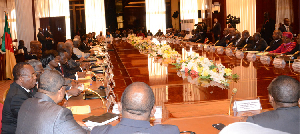Aquaculture, as defined by the United Nations food and Agricultural Organisation (FAO), refers to the culture of aquatic organisms including fish, molluscs, crustaceans and aquatic plants.
The term 'culture' implies here that there is intervention (including stocking at regular intervals, feeding, protection from predators, etc.) in the rearing process to enhance production and an individual or legal breeding stock property.
So therefore, aquaculture products are those harvested by an individual or a legal entity on a property over a period of time for breeding. This is compared to products of fishing, publicly operated as a common property resource, with or without appropriate licenses.
It was in 1948 that aquaculture was introduced in Cameroon. More than six decades later, products of aquaculture in Cameroon (Tilapia, catfish, carp, Kanga) weigh 0.1% in the domestic production of fish, that's around 1 000 tonnes on an annual rated offer to 180,000 tonnes.
To meet the needs estimated at more than 400 000 tons the year, Cameroon, ranked among the top ten countries consumers of fish in Africa, now put on the development of aquaculture to reduce imports. They weigh more than 200 000 tons and cost the State annually, a little more than 100 billion F. In Cameroon, fish provides 44% of the animal protein to households and particularly the most disadvantaged sections of the population. In addition, a recent study indicated that the surveyed families incorporate fish in a meal on two.
Recently the Government has multiplied attentions in the direction of the aquaculture sector, if that, its only potential is sufficient to cover these imports. Indeed, a study conducted a few years ago already, set the Cameroonian aquaculture potential to 170 000 tonnes of fish year.
Compared to the current production, there is everything to do. And to Emma Belal, Director of fisheries, aquaculture and the fishing industries at the Ministry of fisheries, livestock and animal Industries (Minepia), the country has natural potentialities for the development of aquaculture with a dense drainage network with a total area of 4 million hectares and the climatic conditions.
At the end of last week, a forum on the future of fish farming in Cameroon was an opportunity for participants to talk about obstacles to the development of this type of farming in Cameroon.
Row of barriers to the development of the aquaculture sector in Cameroon, include the lack of modern infrastructure, the practice of poor production techniques, lack of training, lack of inputs (FRY) and of quality food and the absence of funding, among other things. Even for private developers encouraged by the Government to invest in this sector, the funding equation remains the main blockage.
The incentives put in place by the Government for the benefit of private operators interested in aquaculture ranging from technical support to the supply of inputs (FRY). The training is no slouch, with the creation of the Institute of fishery science of Yabassi, a nursery active for young people wishing to engage in aquaculture. In addition, projects to develop a commercial aquaculture are underway across the country.
This is the case of the project of ecological intensification of extensive aquaculture systems (SyPiEx) family, in Central Africa and West and Central.
Implemented since 2012 by the West Council, African centre for research and agricultural development (CORAF/WECARD), the project is expected to triple fish production and reduce imports by 15%.
In February 2014, the Minepia opened in Meyomessala in the southern region, a pilot unit of intensive aquaculture for the benefit of young people from this town, expected to produce 17 tons of catfish.
Infos Business of Thursday, 9 April 2015
Source: Cameroon Tribune













